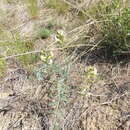Comprehensive Description
provided by North American Flora
Homalobus podocarpus (Hook.) Rydb. Bull. Torrey Club
51: 18. 1924.
Phaca podocarpa Hook. Fl. Bor. Am. 1: 142. 1831. Not .4 stragalus podocarpus C. A. Meyer. 1831. Astragalus sclerocarpus A. Gray, Proc. Am. Acad. 6: 225. 1864. Tragacantha sderocarpa Kuntze, Rev. Gen. 948. 1891.
A perennial, with a cespitose rootstock; stems branched, canescent-strigose, striate, 3-6 dm. high; stipules triangular, free, 3-4 mm. long; leaves 8-10 cm. long; leaflets 13-19, linear or oblong, 1-2 cm. long, 1-3 mm. wide, strigose-canescent, obtuse; peduncles 5-10 cm. long; racemes lax, 5-8 mm. long; bracts lanceolate, 2-3 mm. long, about equaling the pedicels; calyx strigose, more or less black-hairy, the tube about 5 mm. long, 3 mm. broad, slightly gibbous above, the teeth lanceolate, 1.5 mm. long; corolla ochroleucous; banner 14 mm. long, obovate, with a broad claw; wings 12 mm. long, the blade about equaling the claw, obliquely oblonglanceolate, with a rounded basal auricle; keel-petals about 10 mm. long, the blade shorter than the claw, nearly semicircular; pod strigose, stipitate, the stipe 15-18 mm. long, bent, the body lunate, long-attenuate at both ends, reticulate, coriaceous, with very strong thick sutures; seeds nearly black, obliquely reniform, 3 mm. long, 2 mm. broad.
Type locality: Great Falls of the Columbia. Washington. Distribution: Washington and northern Oregon.
- bibliographic citation
- Per Axel Rydberg. 1919. (ROSALES); FABACEAE; PSORALEAE. North American flora. vol 24(1). New York Botanical Garden, New York, NY
Physical Description
provided by USDA PLANTS text
Perennial, Herbs, Stems woody below, or from woody crown or caudex, Plants with rhizomes or suckers, Taproot present, Nodules present, Stems or branches arching, spreading or decumbent, Stems prostrate, trailing, or mat forming, Stems less than 1 m tall, Stems solid, Stems or young twigs sparsely to densely hairy, Leaves alternate, Leaves petiolate, Stipules conspicuous, Stipules membranous or chartaceous, Stipules persistent, Stipules free, Leaves compound, Leaves odd pinnate, Leaf o r leaflet margins entire, Leaflets opposite, Leaflets 5-9, Leaflets 10-many, Leaves hairy on one or both surfaces, Inflorescences racemes, Inflorescence axillary, Bracts very small, absent or caducous, Flowers zygomorphic, Calyx 5-lobed, Calyx hairy, Petals separate, Corolla papilionaceous, Petals clawed, Petals white, Petals ochroleucous, cream colored, Petals orange or yellow, Petals blue, lavander to purple, or violet, Petals bicolored or with red, purple or yellow streaks or spots, Banner petal narrow or oblanceolate, Wing petals narrow, oblanceolate to oblong, Wing tips obtuse or rounded, Keel petals auriculate, spurred, or gibbous, Keel tips obtuse or rounded, not beaked, Stamens 9-10, Stamens diadelphous, 9 united, 1 free, Filaments glabrous, Style terete, Style persistent in fruit, Fruit a legume, Fruit stipitate, Fruit unilocular, Fruit tardily or weakly dehiscent, Fruit oblong or ellipsoidal, Fruit strongly curved, falcate, bent, or lunate, Fruit rugose wrinkled or reticulate, Fruit fleshy, Fruit coriaceous or becoming woody, Fruit exserted from calyx, Fruit beaked, Fruit glabrous or glabrate, Fruit hairy, Fruit 11-many seeded, Seeds cordiform, mit-shaped, notched at one end, Seed surface smooth, Seeds olive, brown, or black.

